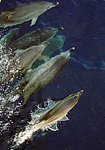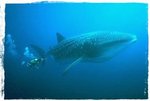Flower Garden Banks National Marine Sanctuary
Contents
- 1 Introduction The Flower Gardens are the northernmost coral reefs in the United States, and are part of the National Marine Sanctuary System (Flower Garden Banks National Marine Sanctuary) . Located about 105 miles directly south of the Texas/Louisiana border, they are perched atop two salt domes rising above the sea floor. Salt formation began 160 to 170 million years ago when salt layers were deposited in what was then a shallow sea subject to evaporation. In subsequent years, miles of sediments were deposited over the salt layers.
- 2 Flora and Fauna
- 3 Further Reading
Introduction The Flower Gardens are the northernmost coral reefs in the United States, and are part of the National Marine Sanctuary System (Flower Garden Banks National Marine Sanctuary) . Located about 105 miles directly south of the Texas/Louisiana border, they are perched atop two salt domes rising above the sea floor. Salt formation began 160 to 170 million years ago when salt layers were deposited in what was then a shallow sea subject to evaporation. In subsequent years, miles of sediments were deposited over the salt layers.
Eventually, internal pressures became great enough to push isolated pockets of salt up through the sediments, forcing the seafloor to bulge upward in distinct domes. The Flower Gardens coral reef community probably began developing on top of the domes 10,000 to 15,000 years ago. The community has thrived sufficiently to obscure all trace of the deformed bedrock on which it developed, forming coral reefs.
The nearest tropical coral reefs to the Flower Gardens are 400 miles away off Tampico, Mexico. Scientists believe that corals at the Flower Gardens probably originated from Mexican reefs when currents in the western Gulf of Mexico carried coral larvae (planulae), other animal larvae, and algal spores northward. A few of the coral larvae were lucky enough to settle on the hard substrate of the Flower Garden Banks and initiated reef growth.
The location of the Flower Gardens bank in the northwestern Gulf provided all the comforts of home for stony corals: a hard surface for attachment, clear sunlit water, warm water temperatures, and a steady food supply. The corals now form the basis for a complex ecosystem, providing a regional oasis for shallow-water Caribbean reef species.
It was this wonderful biological diversity and breathtaking beauty that prompted researchers and recreational divers to seek protection for the Flower Gardens. In the 1970s they launched what would become a 20 year effort, culminating in 1992, to designate the area as the Flower Garden Banks National Marine Sanctuary.
In October, 1996, Congress expanded the Sanctuary by adding a small third bank. Stetson Bank is also a salt dome, located about 70 miles south of Galveston, Texas. Because of its location, average temperatures during the winter are several degrees cooler than at the Flower Gardens. Consequently, the corals do not thrive and build into reefs. Instead, this bank supports a coral/sponge habitat and rich assemblages of associated animals and plants where the siltstone bedrock can still be seen in many places.
Flora and Fauna
Marine Mammals
Although there are no resident mammal species in Flower Garden Bank National Marine Sanctuary, beaked whales, Atlantic spotted dolphins, and bottlenose dolphins have been spotted within and near sanctuary boundaries. These visitors live in the Gulf of Mexico and occasionally pass through sanctuary waters. However, since the footprint of the sanctuary is very small relative to the Gulf, sightings are uncommon. Most of the marine mammals in the Gulf of Mexico are whales. They can be found living alone or in large aggregations, and can dive for extended periods of time, sometimes to great depths.
Fishes
This diverse group includes bony fishes, as well as cartilaginous fishes such as sharks, skates, and rays that live in a variety of habitats including sandy bottoms, open water, and coral and rocky reefs. The area around Flower Garden Banks supports many species of fish, almost 300 of which have been documented at the Flower Garden and Stetson Banks. The sanctuary provides critical habitat for many recreational and commercially important fish species, which play an important role in the ecosystem and our economy.
Marine Birds
Seabirds do not comprise a taxonomic or evolutionary group of birds; they are simply defined as birds that spend most of their life feeding and living on the open ocean, coming to land only to breed. Since Flower Garden Banks lies in the middle of the Gulf of Mexico with no surrounding land for over a hundred miles, seabirds are an uncommon sight in sanctuary waters. Occasionally, migrating warblers and other birds that are moving from one place to another pass over Flower Garden Banks, but no birds can be considered residents or common visitors to the sanctuary.
Invertebrates
Marine invertebrates are the most diverse and abundant group of organisms in the ocean. This grouping is not based on a single taxon, but is defined as animals lacking a vertebral column. An incredible array of invertebrates is found within all the [[habitat]s] of the sanctuary including the coral and rocky reefs, sand flats, and open ocean. Thirty-three species of corals and over 250 species of other invertebrates have been identified in Flower Garden Banks National Marine Sanctuary, including corals, sponges, urchins, oysters, lobsters, snails, octopus, shrimp, jellyfish, and many others. Many of these species are recreationally important within the sanctuary, while a few are commercially important on a regional scale.
Plants and Algae
Marine macroalgae ("seaweeds") are crucial components of most temperate and tropical marine communities worldwide. Algaes are not only primary producers forming the base of most food chains, they also provide substrate, oxygen, and shelter for numerous species. More than 80 species of green (Chlorophyta), brown (Phaeophyta) and red (Rhodophyta) algae have been identified at Flower Garden Banks National Marine Sanctuary.
Marine Reptiles
Reptiles are relatively uncommon residents of the marine environment. Of the small group of reptiles that inhabit the sea, the most common and easily recognized are the sea turtles. There are only seven species of sea turtles worldwide, and all but one are endangered. Three species of sea turtles have been sighted in Flower Garden Banks National Marine Sanctuary: loggerhead, hawksbill, and leatherback. However, only the loggerheads are permanent residents.
Further Reading
| Disclaimer: This article is taken wholly from, or contains information that was originally published by, the National Marine Sanctuary. Topic editors and authors for the Encyclopedia of Earth may have edited its content or added new information. The use of information from the National Marine Sanctuary should not be construed as support for or endorsement by that organization for any new information added by EoE personnel, or for any editing of the original content. |




